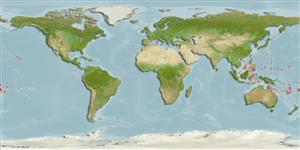>
Ovalentaria/misc (Various families in series Ovalentaria) >
Pomacentridae (Damselfishes) > Pomacentrinae
Etymology: Pomacentrus: Greek, poma, -atos = cover, operculum + Greek, kentron = sting (Ref. 45335); spilotoceps: Name from the Greek 'spilotos' for spotted and 'ceps' as short for head, referring to the orange or yellow spots on the head, its most characteristic markings..
More on author: Randall.
Environment: milieu / climate zone / depth range / distribution range
экология
морской ассоциированный с рифами; пределы глубины 0 - 5 m (Ref. 86942). Tropical
распространение
страны | регионы FAO | Ecosystems | места находок | Point map | интродукции | Faunafri
South Pacific: Fiji and Tonga.
Size / Вес / Возраст
Maturity: Lm ? range ? - ? cm
Max length : 7.8 cm SL самец/пол неопределен; (Ref. 54980)
колючие лучи спинного плавника (общее число): 8; членистые (мягкие) лучи спинного плавника (общее число): 14-15; колючие лучи анального плавника 2; членистые (мягкие) лучи анального плавника: 15; позвонки: 26. This species is distinguished by the following characters: D XIII,14-15 (usually 15); A II,15; pectoral rays 18; tubed lateral line scales 17-18 (usually 18); total gill rakers 22-24; sub-orbital naked and the margin serrate; posterior edge of pre-orbital with a strong retrorse spine; body depth 1.95-2.1 in SL; longest dorsal spine 1.55-1.65 in HL; second anal spine 1.4-1.5 in HL. Colouration: yellowish brown, scale edges blackish; dull yellow to pale orange spots on opercle and anterior to and above pectoral fin base; two blue lines on side of snout crossing the upper lip; a small vertically elongate deep blue or black spot at the upper end of gill opening, a small black spot at upper pectoral fin base; in adults the ocellus posteriorly in lower half of dorsal fin may be present or absent; caudal fin abruptly yellowish (Ref. 124650).
Occurs on shallow coral reegs in calm areas (Ref. 124650). Diurnal species (Ref. 52881). Oviparous, distinct pairing during breeding (Ref. 205). Eggs are demersal and adhere to the substrate (Ref. 205). Males guard and aerate the eggs (Ref. 205).
Life cycle and mating behavior
половая зрелость | размножение | нерест | икра | Fecundity | личинки
Oviparous, distinct pairing during breeding (Ref. 205). Eggs are demersal and adhere to the substrate (Ref. 205). Males guard and aerate the eggs (Ref. 205).
Randall, J.E., 2002. Two new damselfishes of the genus Pomacentrus from the south-west Pacific. aqua, J. Ichthyol. and Aquat. Biol. 5(4):167-176. (Ref. 124650)
Статус Красного Списка МСОП (Ref. 130435)
Угроза для людей
Harmless
Использование человеком
дополнительная информация
Возраст/РазмерыростЗависимость между длиной и массой телаЗависимость между длинамиРазмерный составморфометрияморфологияличинкидинамика численности личинокпополнениечисленностьBRUVS
ссылкиаквакультура (рыбоводство)особенности рыбоводствастепень растяжениягенетикаElectrophoresesнаследуемостьболезниобработкаNutrientsMass conversion
соавторыизображенияStamps, Coins Misc.звукиCiguateraскоростьтип плаванияжаберная областьOtolithsмозгзрение
инструменты
Специальные отчеты
Скачать в формате XML
ресурсы в Интернет
Estimates based on models
Preferred temperature (Ref.
123201): 25.1 - 29.4, mean 28.4 °C (based on 1179 cells).
Phylogenetic diversity index (Ref.
82804): PD
50 = 0.5000 [Uniqueness, from 0.5 = low to 2.0 = high].
Bayesian length-weight: a=0.02399 (0.01139 - 0.05051), b=2.98 (2.81 - 3.15), in cm total length, based on LWR estimates for this Genus-body shape (Ref.
93245).
Trophic level (Ref.
69278): 2.7 ±0.3 se; based on size and trophs of closest relatives
устойчивость к внешним воздействиям (Ref.
120179): высокий, минимальное время удвоения популяции до 15 месяцев (Preliminary K or Fecundity.).
Fishing Vulnerability (Ref.
59153): Low vulnerability (10 of 100).
Nutrients (Ref.
124155): Calcium = 428 [151, 957] mg/100g; Iron = 1.08 [0.54, 2.44] mg/100g; Protein = 17.4 [15.8, 18.8] %; Omega3 = 0.127 [0.050, 0.296] g/100g; Selenium = 9.29 [3.14, 25.41] μg/100g; VitaminA = 480 [88, 2,512] μg/100g; Zinc = 4.35 [2.39, 7.67] mg/100g (wet weight);
